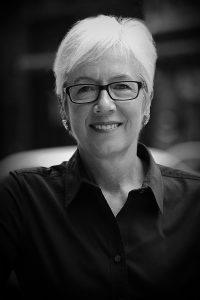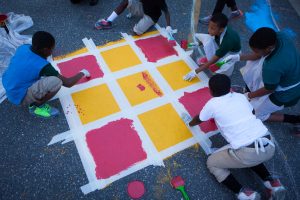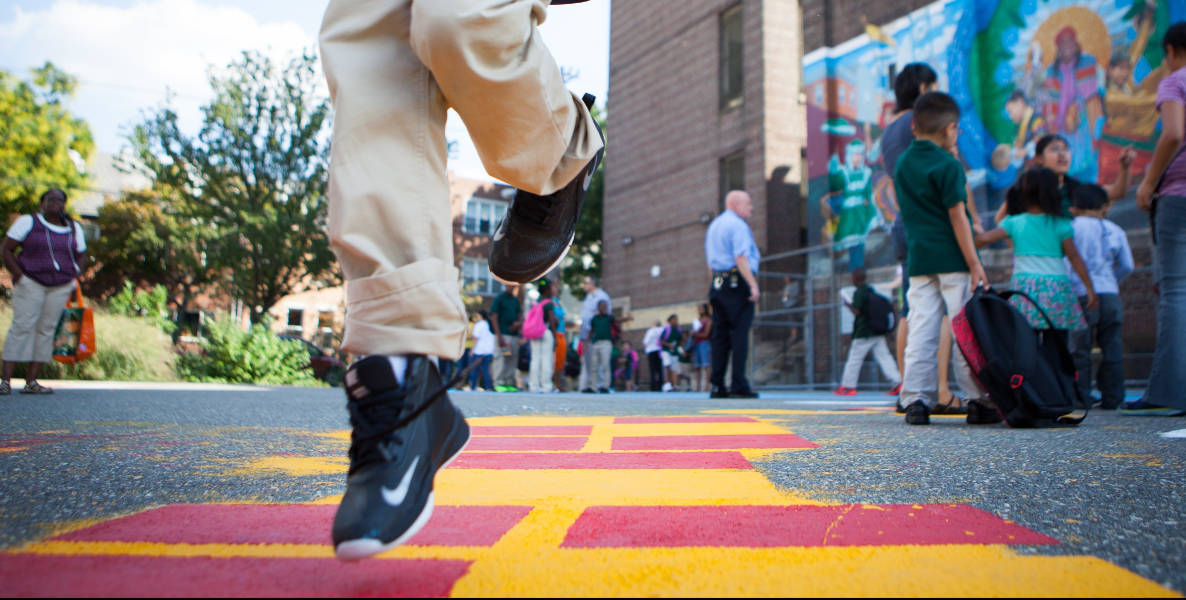Mayor Jim Kenney, along with other city and school officials, have announced their intention to create community schools—neighborhood centers that combine academic and social services to improve both classroom learning and the health of a neighborhood. Inherent in the idea is that a school community is more than just a building filled with students and teachers—it’s a neighborhood working together to learn, heal and grow. To landscape architect Lois Brink, creating a school community begins outside—by inviting the community into the schoolyard.
A Philadelphia native and a professor of Landscape Architecture at University of Colorado, Brink has spent the last 25 years turning Denver’s 96 public elementary schoolyards into “learning landscapes” that serve a dual purpose: During school hours, the yards provide students with a safe space for structured and unstructured play, allow them to learn by exploring nature, help increase physical activity. During off-hours, the schoolyards are open to local families. The new playgrounds, designed individually with and for neighborhoods, turned what used to be asphalt wastelands into green gathering spaces that have transformed the way neighbors interact with each other.

Now Brink has brought her project, called Big Sandbox, to Philadelphia—a city whose complicated school governance structure had until recently given it a reputation for being closed to new ideas.
“It was the behemoth that everyone said just couldn’t be done,” Brink says. “But we don’t have the luxury anymore to say that schools are for school children and parks are for the general public . . . I think everyone realizes now, there aren’t the dollars out there to do that.”
Brink first thought about schoolyards in 1992, when her daughter enrolled in Denver’s Bromwell Elementary School. She was horrified to see that the playground her child would use at recess was a dilapidated “sea of pea gravel and asphalt,” with a few pieces of 50 year-old equipment. As she learned, this was the norm at public elementary schools throughout Denver—and around the country, including Philly. “At some point 50 years ago, we just stopped investing in these spaces,” says Brink.
It took Brink six years to turn her daughter’s schoolyard into “an outdoor area that supports physical activity, learning and improved social interaction,” and three more years to finish a second Denver school. In 2001, she formed a public-private partnership called the Learning Landscapes Alliance, which over the next three years raised $10.6 million, allowing it to redevelop 22 additional schoolyards. (Brink took up the name The Big Sandbox when she moved her efforts to Philadelphia.) By 2003, every school in the district wanted one of Brink’s Learning Landscapes. And Denver voters complied, approving two separate bond measures in 2003 and 2008 that allowed Brink and the Denver Public Schools to renovate every single elementary schoolyard by 2012.
Improving the schoolyard—the most visible and public part of the school itself— reconnects communities with their schools, something desperately needed in this city.
A former Denver Councilwoman noted that the success of the schoolyard remodels was Brink’s use of the community to design the parks. “To say ‘no’ to the 2008 bond measure to complete Learning Landscapes across the city would have been to say ‘no’ to citizen engagement,” she told the American Society of Landscape Architects.
One study funded by the Robert Wood Johnson Foundation and another funded by the NIH found that students used Learning Landscape playgrounds significantly more often than older, unimproved playgrounds—sometimes by 300 percent more— with a sizable decrease in sedentary children. They also found that these differences were consistent for newly constructed Learning Landscape playgrounds, as well as ones that were built at the beginning of the process, proving that the new playgrounds provided lasting changes.
Other cities have followed suit. In 2013 Boston completed it’s city-wide redesign of every public school playground in the city. A similar initiative has been completed in Houston, and Chicago has started a similar program. Brink, who grew up in Mt. Airy, and went to Penn, started looking at her hometown at the urging of a former graduate student who lives here, just as she finished the last schoolyard in Denver.

In Philadelphia, Brink began working with a handful of schools that already have partnered with the Philadelphia Water Department to replace their asphalt with a green surface that reduces the amount of stormwater pollution entering the waterways. (The partnerships help PWD meet its goal of reducing stormwater runoff by 85 percent, and provide schools with soft play areas.)
Principal Todd Kimmel of Horatio B. Hackett in Kensington says he hopes to turn his schoolyard into a reflection of the good work going on inside the school and to be a welcoming beacon for neighbors. “When you look at it from the outside, it’s all concrete and blacktop and has very small windows,” Kimmel says. “It doesn’t really convey what’s going on inside of the building. We have great teachers, great families that already go to this school, great kids. This project could be a transformational piece for people to see a beautiful space and also attach it with Hackett.”
In other words, improving the schoolyard—the most visible and public part of the school itself— reconnects communities with their schools, something desperately needed in this city.
At South Philly’s George W. Nebinger Elementary as at Hackett, creating a new schoolyard is a community effort. Over the last year, Brink and her “mighty but tiny group” have been working with the students, faculty, parents, and surrounding community to design a schoolyard that works for their particular needs. The principal wants a space that can be incorporated into the curriculum, using green areas to teach students about science and nature. But then there are other considerations, such as age-appropriate play equipment and areas for parents to sit while their kids use the playground during off-hours.
“We’ve already got this great geographic distribution of elementary schools,” Brink says. “They are this perfect patchwork within a city, that if they were redeveloped, would not only help children during the day, but would also help the children before school and after school, would help their community before school and after school and over the weekends.”
The school and the community together need to raise 2 to 6 percent (2 percent in cash and the rest can be in kind) of the more than $500,000 necessary to build these spaces. (The rest comes from grants, donors or—as in the case of Denver—the city.) This increases the sense of ownership that the local community feels towards the schoolyard, without which the continued upkeep of the schoolyard is unsustainable. (Similar to the way the Mural Arts Program uses community input to design a mural.) To raise excitement (and money) about the project, The Big Sandbox held a launch event at Nebinger where they invited the neighborhood and students to paint the aspects of the new plan on the existing space. These types of events are key to sustaining enthusiasm about a process that can take years to implement.
“We’ve already got this great geographic distribution of elementary schools,” Brink says. “They are this perfect patchwork within a city, that if they were redeveloped, would not only help children during the day, but would also help the children before school and after school, would help their community before school and after school and over the weekends.”
Just as in Denver, the first few schoolyards are going to take the most time, because Brink and her team have to not only change the play equipment, but a city-wide perception of schoolyards. Over time, Brink says Denverites grew to see playgrounds as part of their parks system, rather than school entities, and as economic development generators, like how a grocery store or a hotel increases neighborhood investment. That helped generate excitement about the projects citywide. “That change in perspective in terms of the capital improvements and their value, that piece hasn’t happened yet in Philadelphia,” Brink says.
What the Big Sandbox is trying to do in Philadelphia is not just build a schoolyard, but build a movement. “It’s about starting an avalanche and when you do that you are setting off charges here and there and here and there,” Brink says. “We are trying to get as many people excited about this as we can in different ways, and then try to provide support in any way, shape or form that we can.”
Header Photo by Timothy Stevens (via The Big Sandbox)




